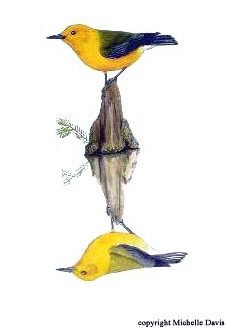| |
SITE DESCRIPTION
The Fort Morgan study
site (30o10'N, 88o00'W) is located within
Bon Secour National Wildlife Refuge on the Alabama coast.
The site is near the tip of a narrow peninsula separating
Mobile Bay from the Gulf of Mexico. This strip of land
is 700 m wide at the site, and several habitats exist in long,
narrow east-west bands. Crossing the peninsula
from south to north, one passes through the entire sequence
of habitats.
|
|
On the south side
adjacent to the Gulf, beach and primary dunes are backed
up by a wide marsh meadow. A view looking south
across the marsh meadow is shown to the right.
North of this meadow a zone of sparsely vegetated dune
merges abruptly into a band of evergreen scrub.
|
 |
|
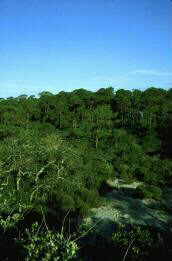 |
Abundant
scrub plants include sand live oak (Quercus geminata),
Chapman oak (Quercus chapmanii), and rosemary
(Ceratiola ericoides). The scrub is shown
to the left (note the pine forest in the background).
Along
the bay side of the peninsula is the remaining habitat,
a forest of slash pine (Pinus elliotii). Gallberry
(Ilex glabra), saw palmetto (Serenoa repens),
wax myrtle (Myrica cerifera), and fetterbush
(Lyonia lucida) are all abundant in the dense
understory of this forest between swampy pools.
A photo of the forest showing the understory is to the
right.
|
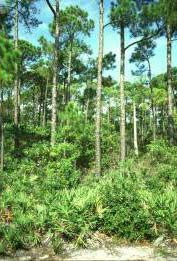 |
RESEARCH ACTIVITY
We've been working here
since 1990. During the
field season, approxiamately 26 mist-nets are operated
daily at the site, weather permitting. We capture
about 3,500 birds per season with an average effort
of about 7600 net hours. Over 12 seasons of operation,
132 species of birds have been captured.
Click
here for a complete table
of all the birds captured at the Ft. Morgan study site
over the years.
Additionally,
during the 1993 and 1995-1998 field seasons, a single
observer conducted counts of migrating hawks at this
site. Mean effort was 207
hours/season. Sixteen species were recorded. We
have also collected ceilometer observations, wing tracings,
fecal samples, and data on vegetation, arthropod abundance,
and weather during some years.
|
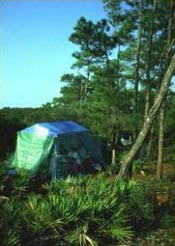 |
| |
JEFF FARRINGTON
Jeff studied the
habitat use of frugivorous migrants during fall migration
using mist-netting data collected from 1997-2002. He
compared capture rates of frugivourous birds between
two habitats, pine palmetto and pine scrub-shrub. He
found that the pine palmetto habitat had the highest
fruit plant abundance.
Frugivores, with
the exception of one species, Indigo Bunting (Passerina
cyanea), were captured more in the pine palmetto
over the six year period. Abundance though is not always
a good indicator of how an individual migrant uses the
available habitats since a bird is, for the most part,
only detected once based on counts or captures.
During 2001, Jeff
radio-tracked individual Gray Catbirds (Dumetella
carolinesis) to study how individual birds use habitats
at this stopover site. Radio-tagged catbirds selectively
used pine palmetto habitat and, within the pine palmetto
habitat, their locations were associated with fruiting
plants more than non-fruiting plants.
|
STEF WOLTMANN
Using radio telemetry,
Stef studied the habitat use of three Sharp-shinned
and three Cooper's Hawk during autumn migration on the
Fort Morgan peninsula in 1997 and 1998. Hawks
were captured, fitted with a very small (< 3g.) radio
transmitter attached to their central tail feathers,
and released. Birds were monitored continuously for
as long as possible, which usually meant less than two
days.
Sharp-shinned
Hawks were found to use wooded areas exclusively, even
though these areas comprise a fairly small proportion
of the available habitat (ca. 20%). Cooper's Hawks were
less dependent on forest habitat, but still used forested
areas disproportionate to their availablity.
Due to development,
wooded areas are fast disappearing from the Gulf coast.
While certain songbirds that migrate through this area
may be more flexible in their use of habitat types, Sharp-shinned
Hawks seem restricted to forested areas. Given the large
numbers of Sharp-shinned Hawks that migrate along the
Gulf coast in the fall, it is clear that management schemes
should include the preservation of remaining forested
areas. |
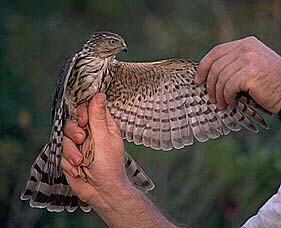 |
DAVID CIMPRICH
David studied predation
risk and the predator avoidance behavior of migrants. He focused
on the behavior of several abundant migrants at the site,
the Gray Catbird (Dumetella carolinensis), Blue-gray
Gnatcatcher (Polioptila caerulea), and American Redstart
(Setophaga ruticilla). For migrating
passerines, much of the predation risk comes from migrating
hawks and falcons. Along the Fort Morgan peninsula, both migrating
passerines and migrating hawks concentrate and provided excellent
conditions for his study. Additionally, the narrowness
of the peninsula facilitated the counting of migrant hawks.
David found that the
passage of bird-eating raptors was variable and unpredictable
among days and years. A predation risk index based on the
ratio of indices of predator and prey abundance also varied
greatly among days and years. Therefore, he suggests that
birds migrating during the same period as the raptors should
be selected to respond behaviorally to short-term variation
in risk. Accordingly, foraging observations revealed that
the behavior of Blue-gray Gnatcatchers and American Redstarts
was related to the abundance of bird-eating raptors. These
birds moved at progressively slower rates and foraged deeper
within shrubs as number of predators increased.
David also found that
fat can affect the predator avoidance behavior of Gray Catbirds.
After exposure to a model hawk, fat individuals remained motionless
longer than lean individuals.
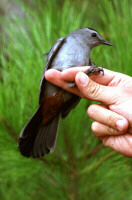 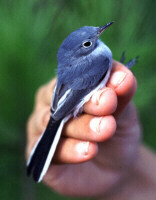 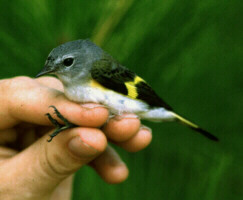
Not all migrants at the site
are birds.
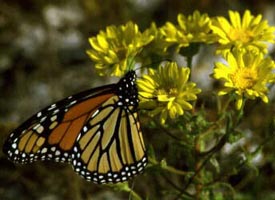
The
University of Southern Mississippi. Last modified:
24 February, 2007
.
Questions and
Comments?
URL: http://www.usm.edu/mbrg/FtMorgan.html
AA/EOE/ADAI
|
